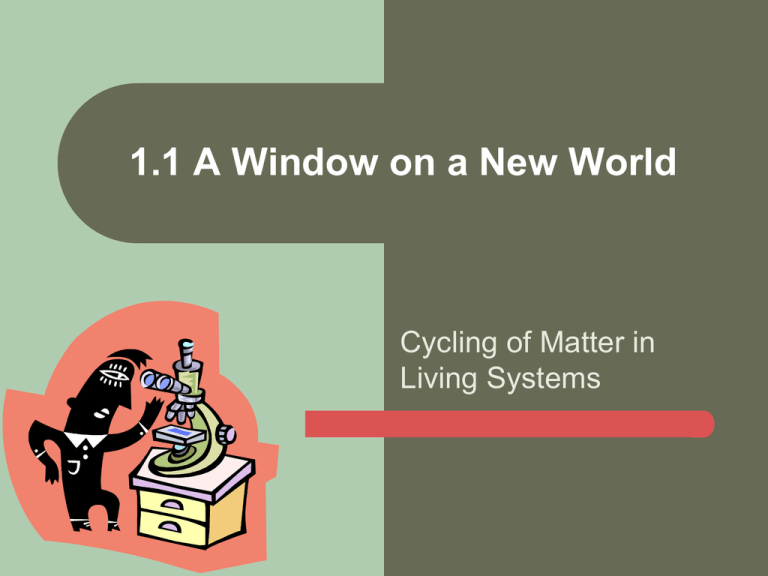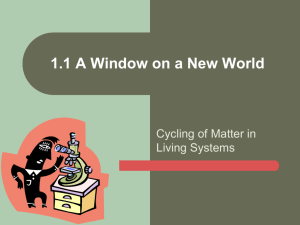1) 1.1-1.2 - MrsLeinweberWiki
advertisement

1.1 A Window on a New World Cycling of Matter in Living Systems Early Microscopes and Microscopists Hans and Zacharias Janssen, Dutch lens-makers, invented the compound microscope in 1595. Compound microscopes use more than one lens to magnify the object Robert Hooke, in 1665, used a three lens microscope to view cork cells Around the same time Antoni van Leeuwenhoek, using only a single lens microscope was the first to seethe movement of single cells that we now know as bacteria. Skill and Practice: Calculating Magnification p. 244 To use a compound microscope to estimate the size of an object you need to be able to calculate the magnification of certain combinations of lenses Magnification = (power of objective lens)(power of eyepiece) The Microscope 1.2 Development of Cell Theory Cycling of Matter in Living Systems Spontaneous Generation Abiogenesis is a theory that states that nonliving things can be transformed into living things. Proposed by Greek philosopher, Aristotle Implied that fish and frogs came from mud, and flies came from rotten meat Scientists accepted this theory for nearly 2000 years At times referred to as "spontaneous generation" Francesco Redi, an Italian physician in 1668 set out to prove flies do not come from meat, by conducting an experiment Pieces of meat were placed in 4 different jars not covered (experimental) Pieces of meat were placed in 4 different jars sealed (control) Experimental group -> attracted flies -> laid eggs -> maggot -> fed on meat -> turned to flies Control group ->no fly attraction -> no flies produced Redi concluded flies did not come from rotting meat But...Air was claimed to be the active ingredient to the rotting meat to produce flies So... Redi used an experimental test, this time covering the container with a very fine mesh, allowing for air flow, but no fly contact Conclusion... Meat cannot be transformed into flies. Louis Pasteur (1822-1895) Boiled broth for a long time -> clear broth ->swan-necked flask -> microbes trapped in curve of the flask Conclusion: microbes could not be created from non-living broth The Cell Theory No one scientist developed the cell theory. Robert Hooke First described cells in 1665, while looking at a piece of cork under a primitive microscope. He saw honeycomb shaped structures and described them as cells. Anton van Leeuwenhoek Observed living blood cells, bacteria, and single-cell organisms – Robert Brown – 1820, described the tiny sphere in the plant cell as the nucleus Theodor Schwann (zoologist) and Mathias Schleiden (botanist) concluded plant and animal tissues are composed of cells prepared the foundations of the modern cell theory The modern Cell Theory states: All living things are made up of one or more cells and the materials produced by these cells. All life functions take place in cells, making them the smallest unit of life All cells are produced from pre-existing cells through the process of cell division Homework: Pg 244 Skill Practice “Calculating Magnification” Pg 246 Check & Reflect, #1-7 Pg 252 Check & Reflect, #1-8 (omit 6)



